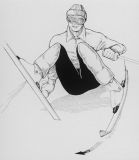Increased knee injuries related to higher binding settings?
Started by Kowal.Ski in Ski Hardware 23-Feb-2017 - 30 Replies
Daved
reply to 'Increased knee injuries related to higher binding settings?' posted Feb-2017
Verbier_ski_bum
reply to 'Increased knee injuries related to higher binding settings?' posted Feb-2017
Edited 1 time. Last update at 24-Feb-2017
Dobby
reply to 'Increased knee injuries related to higher binding settings?' posted Feb-2017
Wanderer
reply to 'Increased knee injuries related to higher binding settings?' posted Feb-2017
If anything, my own anecdotal evidence would be of less, not more, injuries ;) . It seems rare these days to see returning skiers in casts, etc., on the return flights. However, this does not mean that there are less people being carted off the mountain. IMHO, the biggest change in recent years is the increased defensiveness of first responders - if there is the slightest chance of a bang to the head or a person going into shock, they will tend to call for the stretcher or helicopter. The more cynical might suggest that there is an increased inclination to call in the helicopters for relatively minor injuries to ensure that the helicopter service is maintained (with their costs covered by our insurance :evil: )
Of course, there are a myriad range of other factors coming into play - ones that strike me as being particularly relevant include increased use of helmets encouraging people to take more risk, better prepared pistes allowing much faster (and often reckless) skiing, greater numbers of people skiing, better ski technology resulting in faster skiing, increased use of snow making technology (not sure about this one but it seems to me that the manmade snow tends to turn to ice more so than natural snow) :thumbup: .
Dobby
reply to 'Increased knee injuries related to higher binding settings?' posted Feb-2017
Trencher
reply to 'Increased knee injuries related to higher binding settings?' posted Feb-2017
I don't know if there are more or less accidents these days, but two aspects of skiing have changed significantly in the last twenty years. The expectations of what is possible on skis is beyond anything imaginable twenty years ago. On one level, in the terrain parks we see kids routinely doing stuff that was just for the X-games not so long ago. In more conventional skiing, Years ago, a Warren Miller film, or the occasional view of a really good skier on the slopes were all we had to aspire to. These days we can watch endless hours of high performance skiing on youtube, with the result that we are pushing ourselves to be better skiers like never before.
The other thing that has changed on the slopes is the turn shape resulting from more carved turns. I think this is becoming less of an issue, as people have become more used to expecting longer, more rounded turns from others.
I don't think helmets are a direct factor, just a consequence of people skiing at higher levels.
SwingBeep
reply to 'Increased knee injuries related to higher binding settings?' posted Feb-2017
All the alpine countries collect information on the numbers and types of skiing injuries, this is how they break down in Germany.

The situation is much the same in other countries. As you can see the there is a very high incidence of knee injuries, especially for women.
The injuries are often caused by falling backwards. Current ski bindings are mostly designed to release during a simple forward fall (upward release of the heel piece) or during a forward fall with body rotation (sideways release of the toe piece).
The most dangerous situations occur when a skier is leaning too far back. This most commonly happens after a skier has fallen backwards or when they are trying to get up while still moving after having fallen to the rear. The skier's hips fall below the knees and the uphill ski becomes unweighted. All of the weight is transferred onto the tail of the downhill ski. Often the ACL gives way at this point.

In 2013 the Swiss Council for Accident Prevention commissioned a literature study "Ski equipment-related measures to reduce knee injuries" from Prof. Dr.-Ing. Veit Senner of the Technical University in Munich http://www.professoren.tum.de/en/senner-veit/ an acknowledged expert in the field. The full study (140 pages) is in only available in German, but there is a short version in English https://goo.gl/UQUaKy that includes an explanation of the injury mechanisms and details of technical possibilities for the reduction of knee injuries.
I think it's mainly to do with how you fall rather than anything else. Other factors could also include poor skills due to many skiers only taking a nominal number of lessons these days, ski boots that are too big, boot binding setups that force the skier into the back seat, and the excessive consumption of alcohol.
Edited 1 time. Last update at 28-Feb-2017
Dobby
reply to 'Increased knee injuries related to higher binding settings?' posted Mar-2017
Topic last updated on 16-March-2017 at 17:37
